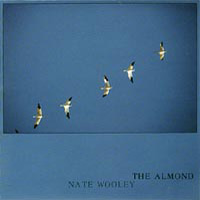 Good luck pinning down New York's Nate Wooley. He's an Oregon-born trumpeter with solo, duo, and quintet projects that deal in free improvisation, extended techniques, feedback, noise, and jazz. He has played with Yoshi Wada, John Zorn, and Anthony Braxton, held residencies at ISSUE Project Room and Cafe OTO; he curates the Database of Recorded American Music online and is editor-in-chief for its quarterly Sound American journal. For The Almond Wooley flies solo, using carefully looped and layered tones to sculpt a beautiful and imposing 72-minute composition for trumpet and voice.
Good luck pinning down New York's Nate Wooley. He's an Oregon-born trumpeter with solo, duo, and quintet projects that deal in free improvisation, extended techniques, feedback, noise, and jazz. He has played with Yoshi Wada, John Zorn, and Anthony Braxton, held residencies at ISSUE Project Room and Cafe OTO; he curates the Database of Recorded American Music online and is editor-in-chief for its quarterly Sound American journal. For The Almond Wooley flies solo, using carefully looped and layered tones to sculpt a beautiful and imposing 72-minute composition for trumpet and voice.
At low volumes or in passing, The Almond might sound like a drone record, and I guess that's accurate to the extent that it is a long, unbroken piece of music composed of sustained tones. But played at louder volumes, as recommended in the liner notes, or given more attention, it sounds less like a drone and more like the audio equivalent of a bas-relief. Each of the looping pitches Wooley uses to build The Almond are made up of several recordings utilizing different tunings, mutes, mics, and environments. By adding and subtracting elements to and from these loops, he transforms apparently smooth and simple tones into layered things with shifting textures, contrasting vibratos, and undulating hues. The bright, relatively smooth grain of his trumpet breaks into grooves, crevices, crests, and furrows, and is joined by other similarly built sounds, which flash and shiver against each other. Nate carefully mixes these, generating harmonies, melodies, textures, and throbbing rhythms in a constant state of flux.
The construction is ingenious and easy to admire, but so are the results. The brassy pitches shimmer beautifully against the finer patterns that cut along its surface. Sections expand and contract as naturally as if they were breathing, but also swell to roiling crescendos. By midway through the record, the very shape of the trumpet comes through in the music: the fleshy buzz of the mouthpiece, the sonorous ring of the bell, even the mechanics of the valves sing. A massive low end, which I cannot identify as a trumpet at all, submerges the brighter sounds in shadow and fills out the thinner places with some muscle. When it drops out, the music is unmoored and floats away lighter than air. It doesn't stop there though. Wooley continues to work and transform his material, shaping it into newer configurations, some of which are quite beautiful. At 72 minutes long, this is still just an excerpt of a longer piece, but I would be happy to follow along for another 72 minutes should Wooley ever think a longer version worth releasing.
samples:
 
Read More

